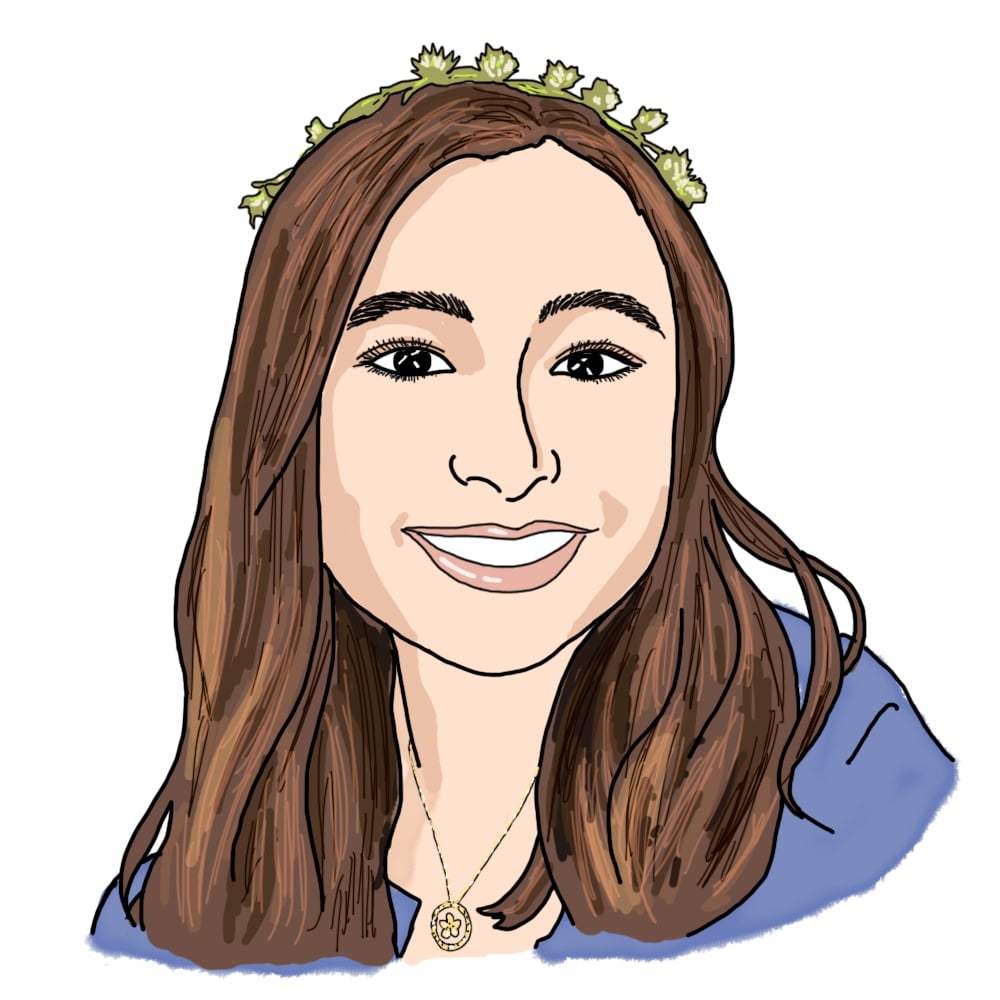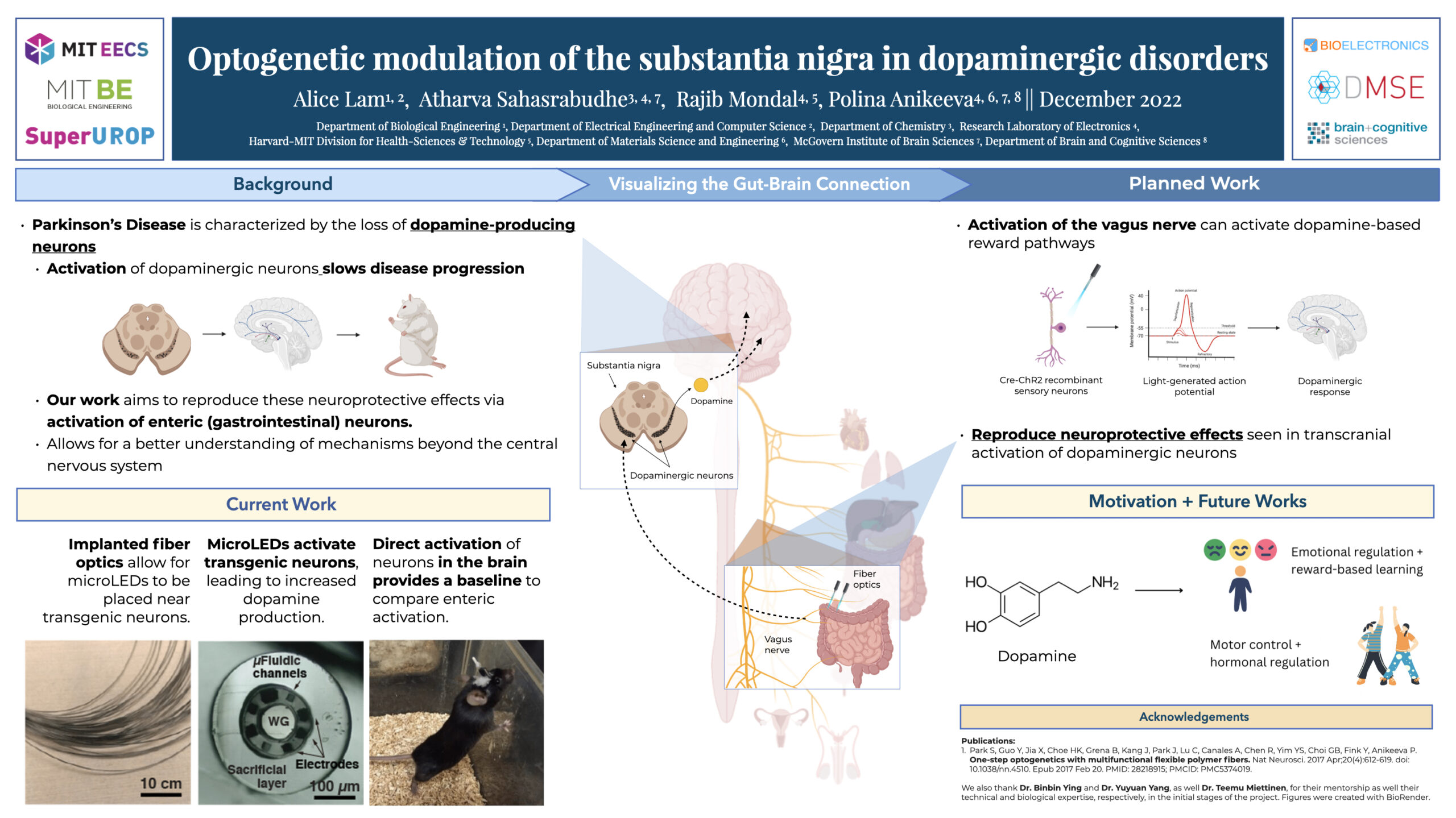
laser-powered happiness by Alice L. '24
6.UAR showcase, part 1
Have you ever wanted to feel happier and thought, hey, maybe if I eat a few lasers for dinner today, things will be better? No? Because you should.01 please do not actually attempt at home
In any case, I spent all semester thinking about laser-powered dopamine production, and now you too! can think about laser-powered happiness! after watching my 3-minute research talk!
This is also probably the most terrifying 3 minutes of my life to date and I have not been able to bring myself to watch it but now I will do it in-person this week!
so how did we get here, anyways?
Last spring, I started talking to a postdoc (Binbin) at MIT’s ice rink, partially because I had given up on trying to dodge his small children for long enough to practice jumps on a public session and decided to just flop around the ice with them instead, and partially because he also worked vaguely in bioengineering and his research sounded cool.
“Let me know if you ever want a job,” he told me, “I’ve been looking for a SuperUROP student anyways.”
To which I went excellent, I like employment, and then we exchanged contact information and I went home and read many papers and filled out the SuperUROP application less than three days before it was due.![]()
In August, the EECS office then notified everyone who was accepted, at which point I started work in the Traverso/Langer Lab. Because Binbin is a lovely mentor who possibly also has too much confidence in me, he essentially let me design my own project based off his work on hydrogels, and so I spent most of September and October doing safety trainings and outlining what exactly I wanted to spend the next 8 or so months doing.
This also meant that I semi-regularly appeared in the door of my old UROP supervisor’s office to ask questions like help, you’re the only real biologist I know — I know how to theoretically gene-edit things with plasmids, but how do I actually go about doing this? at which point he told me that biologists casually just buy genes off the internet, and there’s various paperwork you have to fill out when you want to buy someone else’s genes off the internet, while also going “alice, this is not really a project of a reasonable scope for an undergrad to be doing; no, seriously, you could probably make a thesis out of what you want to do,” and then I would go this is fine! and add my gene-buying plans to the transfection protocol I was writing to convince my PI that I had some idea of what I was doing.![]()
In November, I pitched my entire “buy-genes-off-the-internet, make-transgenic-mice, and laser-them-happier” plan to my PI, who very understandably responded with something along the lines of “yeah, no, this is wildly expensive and definitely a long-term project in a research direction that the lab is not taking right now,” which is probably a reasonable thing to say to an undergrad who wants to embark on a very expensive project. At this point, I had two options:
- Stay in the Traverso Lab, abandon my overly-complicated project, and join in on an existing project — it’s now November and I likely don’t have time to rethink what I want to do from scratch
- Keep my project and find someone else whose lab had the resources to better support what I wanted to do (hint: contains mice)
I felt very attached to my project (I made him! from scratch! he’s my child!) and so I sent out a bunch of emails that more or less said
hello. rehoming a houseplant but instead of a houseplant it’s a superurop student who wants your support. specifically, your mice. please?
except possibly with a few more words explaining my circumstances and with my slide deck attached. Three different professors in
BCS02
Brain and Cognitive Sciences
suggested I talk to Professor Anikeeva, so I did, and thankfully she did want a houseplant SuperUROP student. At this point, she roped in a couple of grad students working in a relevant field onto the email chain, and
now I’m working on my current project!03
after doing yet another lab-specific safety training, which puts me at 6 safety trainings this year
what I proposed, initially
- Generate a mouse model of schizophrenia
- Transfect neurons in their intestines to respond to light
- Embed LEDs and a microcontroller into Binbin’s hydrogels and wirelessly turn on their intestinal neurons to explore the connection between the gastrointestinal system and the brain
what I’m doing, now
- Generate a mouse model of Parkinson’s disease (which aligns with the work of a grad student I’m currently working with)
- Transfect neurons in their intestines to respond to light
- Surgically embed fiber optics to turn on their intestinal neurons to explore the connection between the gastrointestinal system and the brain
It’s not entirely the same as my original proposal, but it is considerably more doable and has the potential to re-expand into what I wanted to do in the first place, so I’m very happy about this.
thoughts on research, after a chaotic semester of research
I made this poster for Thursday’s showcase:

and in the process realized that I don’t like the “safe” option of plain white slides for presentations. It bothers me that professionalism-core exists as an concept. In lecture and in our example slides, plain slides were the default, though they noted that some people are a little bit riskier and make an intentional design statement with their slides. I don’t like the idea that graphic design is unimportant as long as the science is sound, and I wish that spending time learning how to make your slides something other than sans-serif black text on a plain white background was more normalized. For one, color is not a crime; for another, it feels like an unnecessary dictation of what academia should look like and of who belongs in it.
Once, in high school, I had a mentor pull me aside to gently tell me I looked too pretty for people to take me seriously. My school had chosen ten or so seniors to act as student mentors in our STEM extracurriculars, and I could not figure out why they kept pushing me into making promotional material instead of mentoring the math team when I had gotten reasonably far into the world of math contests but had zero business experience and hated getting in front of a camera.
“I know you’re good at math, and I think this is ridiculous,” he told me, “but look at the girls — the people — who get recognized as ‘good at math’. You don’t fit that stereotype, girl or not. You show up nicely dressed all of the time and with a stray cat in your arms half of the time.”
I stopped wearing skirts to class and feeding cats during break after that. I got the message that I was marketable as a model of femininity, but not as an example of competency, because feminine and competent are disjoint events.
The default towards blank slides feel like a soft version of the same idea — of the same aversion to “cutesiness” associated with teenaged girls uwu-ing on Tumblr, of an aversion to unproductive “artsiness” associated with manic pixie dream women in their early twenties. I’m convinced that we, societally, don’t mock young women for liking those aesthetics (or for buying pumpkin spice lattes) because they are inherently wrong to enjoy; rather, they’re things we mock because they are associated with young women. From an aesthetic standpoint, I don’t want to make my slides pastel pink and full of hand-drawn chibi mice, but at the same time, I almost want to do so out of pure spite. Dolores Umbridge should be allowed to be a scientist without being judged for her aesthetic, you know?
For the most part, though, I’m glad that I’ve met a really diverse group of people in UAR presenting a wide range of research topics with an equally wide range of presentation styles, even if blank-white-sans-serif continues to be a safe default option that includes most of the example slides we’re given. My recitation leader and TA have always given relevant feedback on my presentations as a whole, and I like that 6.UAR still supports “riskier” design choices though we don’t really learn much about where to start with visual design. 04 or about the accessibility of our presentation materials -- I've been using https://www.whocanuse.com/ to check my color schemes, but I discovered that in my last CI-M I love that I can find a new topic to obsess over, email people, and then actually get to spend a lot of time and resources working on it, and appreciate the amount of care that went into this project and into me from the 5? 6? mentors I’ve had at this point — I expected people to be considerably more upset that I was suddenly switching labs halfway through the semester, especially after they had invested a lot of time and energy getting my project to where it was, but everyone was very understanding and told me to pursue whatever research excited me.
Back in high school, I started thinking of myself as overly loud and annoyingly assertive, because I was overly loud and abnormally assertive for the environment I was in — and then I came to MIT and spent a solid month of my first UROP feeling like I couldn’t take a lunch break because then I would be perceived as lazy and not worthy of being there. That wasn’t actually true — and my then-supervisor was horrified when I mentioned it — but I was convinced it was, and I’m still pleasantly surprised every time my mentors genuinely want the best for me and tell me to put myself first.
- please do not actually attempt at home back to text ↑
- Brain and Cognitive Sciences back to text ↑
- after doing yet another lab-specific safety training, which puts me at 6 safety trainings this year back to text ↑
- or about the accessibility of our presentation materials -- I've been using https://www.whocanuse.com/ to check my color schemes, but I discovered that in my last CI-M back to text ↑